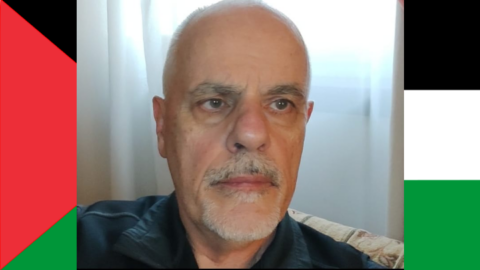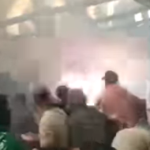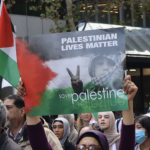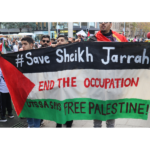Dr Tim Anderson on His Intellectual Freedom Court Victory and “Slow Genocide” in Palestine
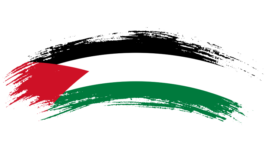
Dr Tim Anderson was victorious on 27 October, after having raised multiple court challenges, which appealed the decision to dismiss him from his position of Sydney University senior lecturer in political economy on the basis of a series of intellectual points he’d been making.
The NTEU (National Tertiary Education Union) backed Dr Anderson all the way through the three court cases that at basis threatened the right to intellectual freedom.
Federal Court Justice Thomas Thawley ruled on 26 November 2020 that the university was not at fault in sacking Anderson as he’d breached the institution’s code of conduct, based on an argument put by the institution that included the assertion that there is no real right to intellectual freedom.
Anderson appealed this outcome to a three justice bench of the Federal Court, which determined on 31 August 2021 that as the Sydney University enterprise agreement specifically upheld the right to intellectual freedom and that was what he’d been exercising in the actions that led to his dismissal.
The case was then remitted back to the lower court for reappraisal, and this time Justice Thawley found that the five comments that had led to a determination that Anderson had committed serious misconduct were actually valid intellectual propositions and therefore, didn’t warrant dismissal.
Apartheid Israel
Dr Anderson’s dismissal and the deliberations in his court cases revolved around five comments made by the lecturer, which conveyed inconvenient truths about wars and atrocities that didn’t toe the party line and therefore, led to mainstream media attacks casting him in a negative light.
The aspect that garnered most media attention to the case was an infographic relating to the number of Palestinian civilian casualties caused by Israel’s assault on what is the open-air prison of Gaza in 2014, as it featured an image of the Israeli flag with a slice of the Nazi flag imposed upon it.
This educational infographic slide outlined that 75 percent of Palestinians killed in the 2014 Israeli onslaught, or 1,088 people, were civilians, whilst in comparison, 6 percent of Israelis killed by Palestinian responses to the attacks were civilians, which accounted for 51 Israeli lives.
The graphic also makes the point that despite Israel being the colonising aggressor with the most advanced weaponry available, the Australian mainstream media and nations supportive of Israel continue to demonise Palestinians, whilst excusing Israel, as it perpetrates the act of genocide.
Intellectual confinement
The points, or examples of inconvenient truths, Dr Anderson has at times made in the lecture room, are those strictly prohibited from being made in the mainstream media, not by law but due to the political outlooks of these companies and corresponding self-censorship on the part of journalists.
But the exceptionally disturbing aspect to Anderson’s case is it reveals that in the same way that the media maintains the party line for its vested interests, so too, are universities veering towards this way of operating, with lecturers expected to engage in the journalistic tactic of self-censorship.
Sydney Criminal Lawyers spoke to Dr Tim Anderson about the outcome of his recent court battle, the parts of the story surrounding it that are misrepresented in the press, and the shifting attitudes about apartheid Israel.
Federal Court Justice Thawley ruled on 27 October that Sydney uni was not justified in sacking you based on a series of statements that it considered constituted serious misconduct, as his Honour found that you were exercising your intellectual freedom.
It was further determined that the institution had breached employment law by issuing two warning statements prior to your dismissal. It took you, with the backing of the NTEU, three courtroom battles to achieve this outcome.
Dr Anderson, why were you so determined to prove that you shouldn’t have been sacked over these matters? What does this victory mean on a deeper level?
There had been a series of unprecedented secret/confidential directions from managers to me to withdraw or not make comments in relation to my work, over almost 18 months, and I could not tolerate that type of political interference with my work.
I refused every such direction. The NTEU decided to fully back me in this dispute as this violation of intellectual freedom would affect all their members.
However, responding to media and private funder pressure is the reality of the corporate university today, so the practical outcomes of this good in-principle decision remains to be seen.
The university has spent millions trying to prevent such an outcome.
There were a series of disputed statements, both written and visual, and perhaps, even physical by your having taken trips overseas to nations like Syria, that led to your ultimate dismissal.
But in the end, the final decision boiled down to an infographic outlining the number of civilians killed in Gaza by Israeli forces, which included an Israeli flag with the Nazi flag superimposed upon it.
How would you describe what that image is ultimately conveying?
Let me correct your summary. First the Gaza graphic was and is a pedagogical tool, showing how to read conflicting sources, in relation to the massacre of Palestinian civilians in Gaza, and the relative scale of civilian casualties from Israeli forces and from the Palestinian resistance.
The constant war media misrepresentation of my Gaza graphic as the image of ‘a swastika on an Israeli flag’ is a gross distortion.
Second, neither side will agree that this Gaza graphic was the basis of the dispute and of my dismissal.
When the then provost Stephen Garton first raised it with me, he did not level any charge of “misconduct” but directed me not to use it again.
I refused and reposted it. The full bench of the Federal Court of Australia last year understood very well why I did this.
After that, Garton raised a series of refusals to follow orders, cumulatively, as the reason for “serious misconduct”, as required for dismissal.
As you will have seen, Thawley in his final judgment found that each of this series of refusals were justified as an exercise of my intellectual freedom. No complaint was made by the university about my visits to other countries.
The Gaza graphic is part of what I consider an important pedagogical initiative called “Reading Controversies”, where in-principle and forensic tools are used to evaluate ongoing propaganda wars, where – especially in the mass media – there are heavily biased or conflicting accounts.
In my teaching, I have applied this method to stories about Venezuela, Syria and Palestine.
The Gaza graphic “image” – really a set of images and text – is of the heavily asymmetrical violence in the 2014 Israeli attack on Gaza, where the Israelis killed 20 times more than the Palestinian resistance and the civilian casualties inflicted by the Israelis were at least 75 percent of those killed, while the Israeli civilian casualties inflicted by the Palestine resistance violence were 6 percent.
The text shows how we can use sources to more reliably estimate such figures.
The background image of an Israeli flag partly obscured by a swastika is a visual comment saying that the Israeli army was acting like Nazi Germany in this racialised massacre of more than 1,000 Palestinians, most of them civilians.
The repost of that graphic – about which Garton complained – was linked to my research article “The Future of Palestine”, now a chapter of my 2019 book Axis of Resistance, which explains the specific parallel – of racialised massacres linked to a pseudo-racial ideology.
Of course, the war media, to this day, removes any reference to the fact that this graphic is about the massacre of Palestinians. Most stories do not even mention Palestine or Gaza. To them an insult to Israelis is more important.
You first challenged your dismissal in the Federal Court in late 2020, with Justice Thawley at that point ruling that the university was justified in dismissing you.
You appealed that decision to a three-justice bench of the Federal Court, asserting you were exercising your intellectual freedom, which was guaranteed under the USYD enterprise agreement. And the justices agreed, the case was remitted back to the lower court.
This time Thawley made statements that were counter to his original position in 2020, including that the graphic was not intended as a form of racial vilification, as was contemplated in the original case.
There have been shifts in public perception around Israel’s occupation of Palestine over the time since Thawley presided over your first case.
Do you think his current findings reflected this shift, or displayed that his attitudes may have changed?
In 2020, the university managers argued that firstly, there was no real “right” to intellectual freedom – it was an aspiration – or, even if there was, then it was subject to the code of conduct which required “courtesy”, non-offensiveness, etc.
So, from there, university managers could give directions about what, in their judgement, was acceptable, and finally, academics had a duty of loyalty to their employer.
Justice Thawley in 2020 accepted all of that. It seems he liked the “insubordination” argument.
The full bench decision in 2021, however, accepted that there was indeed a “right” in the enterprise agreement and that it had specific limits – vilification, harassment, etc – none of which the university had argued against me.
Thawley, in 2022, adopted this logic, quoting it at length, finding entirely for us and completely reversing his 2020 judgement.
It is true that there have been some changes in public mood over Palestine since 2018.
Back then, there were two important independent reports – one from South Africa and an important 2017 report from the USA by Richard Falk and Virginia Tilley – branding Israel an “apartheid” regime.
Now there are six such reports: two more from Palestine/Israel, plus one each from Human Rights Watch and Amnesty International.
This shift is certainly relevant. At the internal review in early 2019, underlining the political nature of the dispute, Stephen Garton said to me, “You should have been even handed”.
I responded, “Even handed to apartheid Israel?” He replied, “Well you can cite reports that say it is apartheid Israel, and I can cite just as many which say it is not.”
This was not just a difference of opinion. We both knew that an Israeli linked group was one of the largest donors to the Faculty of Arts and Social Sciences and that Stephen Garton wanted to defuse the media trolling of the university, through their attacks on me.
However, I don’t think Thawley’s 2022 judgement had anything to do with public opinion. I believe he was simply correcting his errors of 2020, under the directions of the full bench.
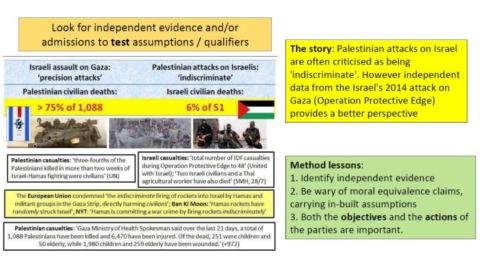
Broadly speaking, how would you describe the way that Israel is treating the Palestinians? And would you say it’s intensifying?
The Israeli treatment of the Palestinian people is a slow genocide which all decent people should oppose. I have written quite a lot on this.
Yes, it is intensifying because there is an accelerated grab for land as the legitimacy of this racialised colony is declining, worldwide.
It is also important to notice that the Israeli colony is a forward base to assist declining US influence in the Middle East. Hence the constant Israeli attacks on Syria and its paranoia about Iran and Hezbollah in Lebanon.
Your dismissal and the court challenges to it involved the right to intellectual freedom, as well as the line where certain statements can border on vilification.
Why is the right worth fighting for? And in your opinion, when is the line crossed?
Yes, I believe intellectual freedom is worth fighting for, especially in a world with dozens of proxy wars which all include heavy propaganda, especially by the war media.
The enterprise agreement at our university excludes “harassment, vilification or intimidation” from such freedom.
I agree but would go further, adding to it exclusions on “gratuitous abuse, inciting racial hatred and promoting propaganda for war”.
But those rules should never indulge secret political directions by university managers, motivated by concern about “offence” to privileged groups.
Thawley gave both parties seven days to come to an agreement about what outcomes his final findings should lead to.
You are right, the lawyers are currently discussing appropriate orders.
So, in conclusion, Dr Anderson, I’d like to ask how your case reflects upon the way Australian universities are operating at present, especially in terms of what’s expected of staff?
I believe the union, the NTEU, sees this as a win for academics generally. But the fragility of this “right to intellectual freedom” is that it depends on the wording of agreements at each university.
What has been decided at the University of Sydney in relation to our 2018 enterprise agreement may not apply elsewhere.
Further, the pressures on the corporate university remain. Notice that Australian universities depend more than ever on private funds and that most managers get contractual bonuses for their performance, which includes fundraising.
The corporate and state media also push certain agendas, which can influence managers. None of that is resolved.
